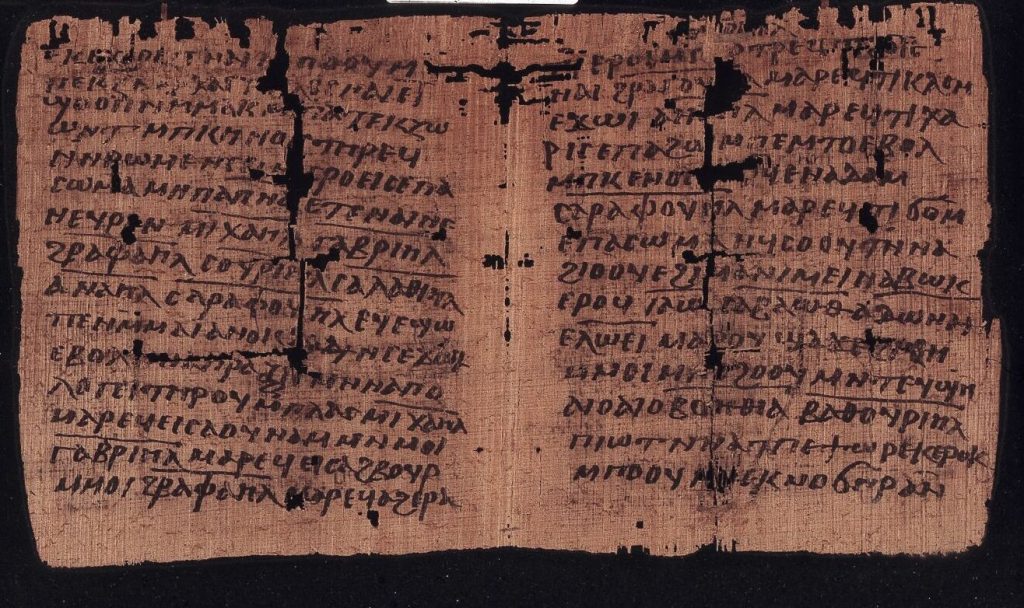
In last week’s post we discussed the four major formats used in Coptic magical formularies – the roll, the codex, the rotulus, and the sheet. As we noted, the roll was the original form of the book, a long horizontal sheet of papyrus written with a series of vertical columns, while the smaller sheet was a smaller piece of papyrus with a single column used for short texts, such as notes. But the period which saw the appearance of Coptic-language magic – the fourth to fifth centuries – was also a period of transformation in writing technology, as the predominant format shifted from roll to codex. This change is an important one, whose consequences are still felt today, and so this post will be dedicated to discussing this change, and the way in which it is reflected in Coptic magical texts. Once again, this post presents some of the material presented by Korshi Dosoo and Sofía Torallas Tovar at the 29th International Congress of Papyrology in July of this year.
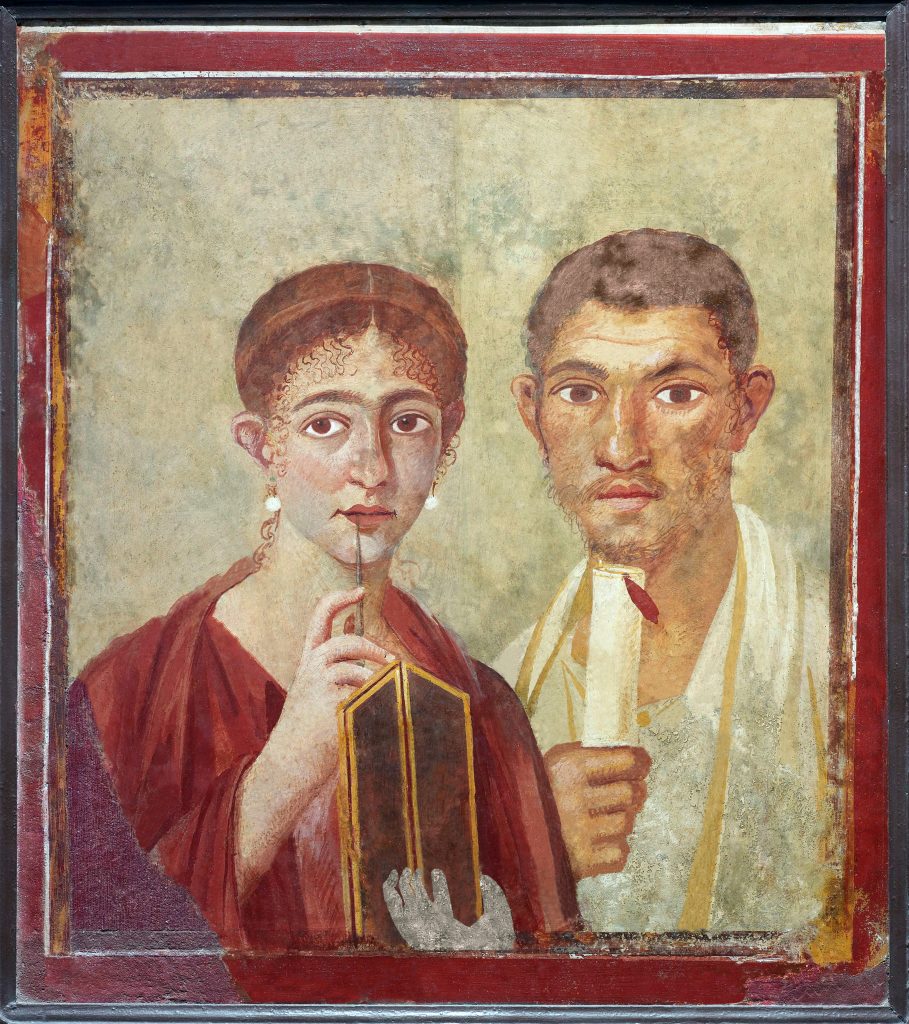
The famous portrait of Terentius Neo and his wife from Pompeii (1st century CE) , showing a Roman couple. The husband holds a roll, while the wife holds a codex of wooden tablets in one hand and a writing stylus in the other. [source] 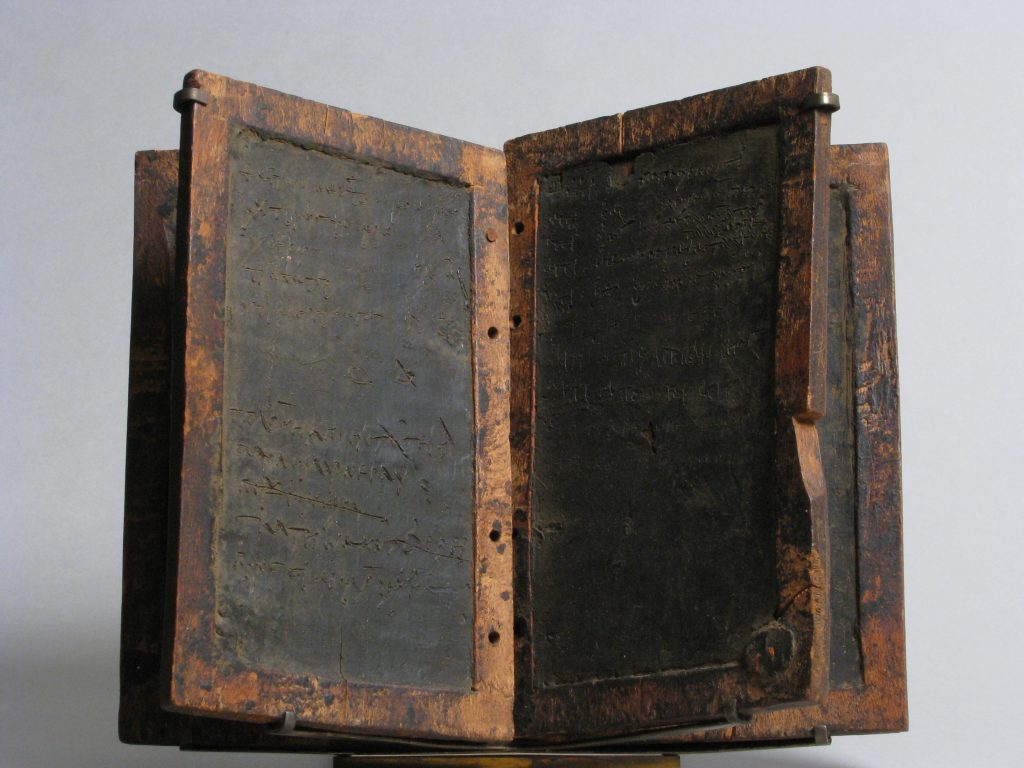
MMA 14.4a-d (6th-7th century, Egypt) a real example of a codex made from wooden tablets coated in wax. Although unpublished, it seems to contain a series of accounts in Coptic and Greek. [source]
One place to begin is with the history of the codex. The word codex comes from Latin, and originally referred not to a book on parchment or papyrus, but rather to a document made from multiple wooden tablets tied together. Tablets, particularly in the Roman culture, were regularly used for taking notes – they would be cut down to size, and often painted white or, even better, coated in wax. Often two of these would be made into mini two-page codices, called diptychs. Writers would scratch the wax with pens, the back ends of which had flat points to erase by smoothing the wax. These tablets were thus much more versatile than writing on papyrus with ink – they did not require the pen to be constantly dipped in ink, or mistakes to be painstakingly washed or sanded away. The experience of writing on them was therefore much closer to that of using a modern pencil or even word-processor, and ancient writers mention that this allowed thoughts to flow freely in composing texts, while trained stenographers could transcribe texts verbatim as quickly as they were spoken.
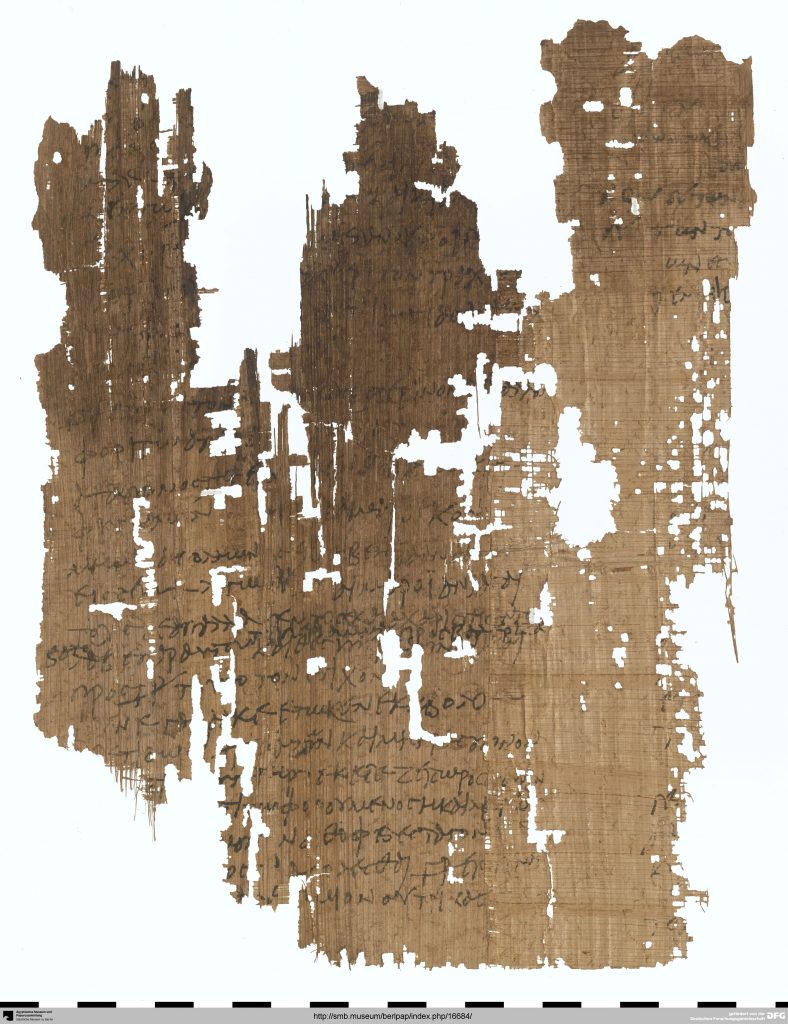
These wooden codices seem to have led to the creation, perhaps in the first-century BCE, of parchment codices, which were originally used as notepads by professionals such as lawyers and doctors. We have a few surviving examples of these, including one papyrus codex from the fourth century, belonging to Aurelios Philammon, a tax collector from Hermopolis who kept records relating to his job, alongside some legal cases that he seems to have been studying, and even a few magical recipes.
By the first century CE, at least in Rome, these parchment codices began to be used to write literary texts as well as for note-taking. Most of our information on the adoption of the codex comes from Egypt, the source of most surviving texts from antiquity, and so may not reflect practices elsewhere. However, Benjamin Harnett has made a good argument that in Egypt, at least, the adoption of the codex follows the S-curve typical of innovations, first described by Bryce Ryan and Neal Gross in a study of the adoption of hybrid seed-corn in early 20th-century Iowa. This model describes how new innovations are adopted slowly, initially by “innovators” and “early adopters”, who are less tied to tradition and open to experimentation. Gradually the rate of adoption speeds up, as the majority begins to take up the new technology, before slowing again as a few traditionalist “laggards” serve as the final holdouts. We can compare this to the use of e-books in the 21st century – while the technologically savvy have embraced them with open arms, many people still don’t see them as “real books”, and prefer to stick to traditional printed paper books for aesthetic or practical reasons. In the same way, ancient readers may have seen the codex as a less prestigious format than the roll, which had, after all, been used for thousands of years, and hence not as a “real book”. Nonetheless, codices did have advantages – they were somewhat more portable than rolls, perhaps easier to store, and could contain more text, since each page was written on both front and back, whereas rolls were typically written on only one side.
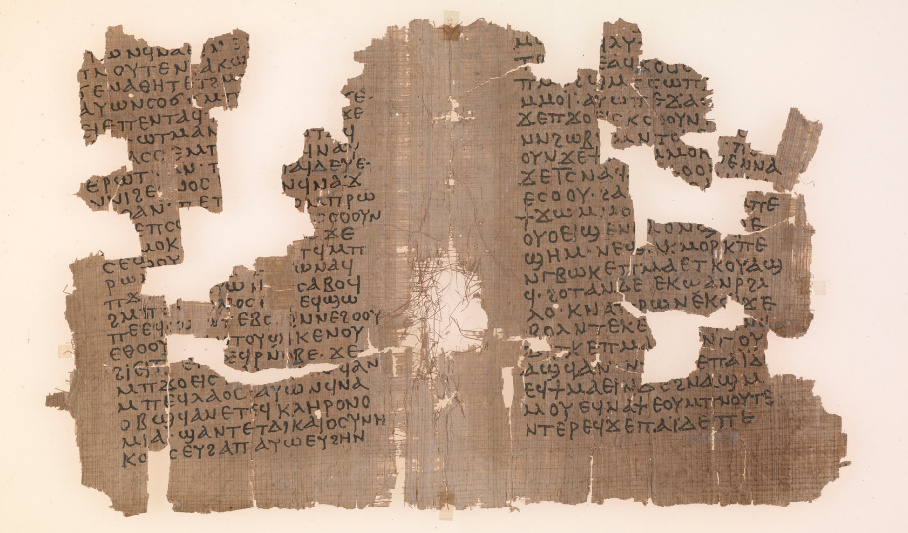
So while the codex first appears in Egypt in the first century CE, it does not become the predominant format until the fourth century, and it is only in the fifth century that it (almost) completely displaces the roll. One interesting detail, though, is the fact that Christians seem to have been early innovators – almost all major Christian texts, including the Old and New Testament – seem to have been primarily written as codices from at least the second century. There has been a lot of debate about this point – about why Christians preferred the codex, and whether the rise of the codex should be connected to the rise of Christianity. Roger Bagnall and Benjamin Harnett have both made good arguments that the codex was already in the course of being adopted by non-Christians, so that the two developments are separate, but the reasons that Christians preferred the codex continue to be debated. Perhaps its portability made it suitable for travelling preachers, perhaps it became the standard form of a set of scriptures – the Pauline letters or the Gospels – early in its history, perhaps Christianity, as a new religion, was simply more open to new writing technology. In any case, because most Coptic magical texts are Christian, and written later than the fourth-century, the codex is a major format among our corpus.
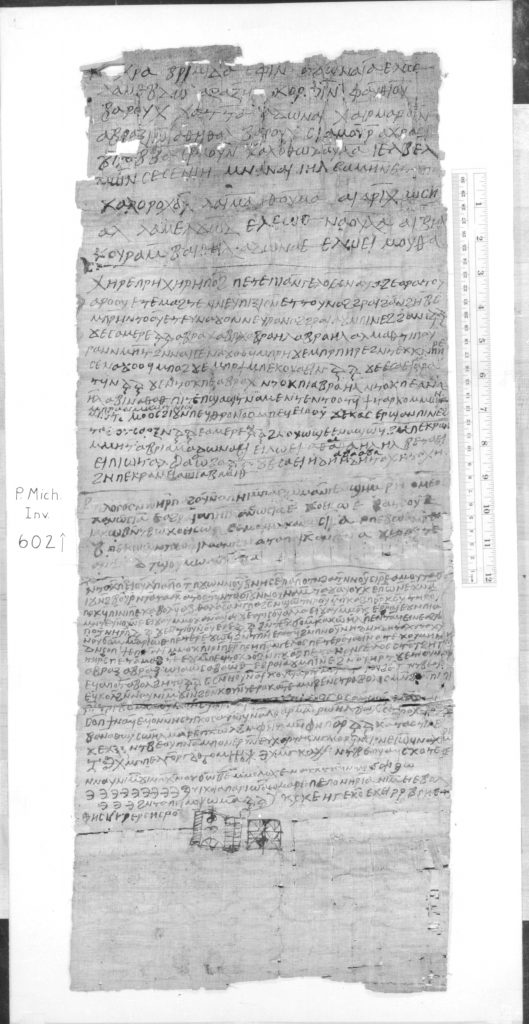
But alongside the codex, another new format appeared to take the place of the roll, the rotulus, or vertical roll. While we have a few examples of this kind of manuscript from the Ptolemaic period (4th-1st century BCE), it was quite rare until the fifth century CE, when changes in the centralised production of papyri meant that it became one of the standard formats for the production of documents, such as testaments. Marco Stroppa notes that literary texts began to be written on rotuli from the sixth century CE onwards, and this also seems to be more or less true for magical texts – we have a few Greek examples from the fifth century, and many Coptic from the sixth onwards. It’s difficult to say why scribes might have used the rotulus format rather than that of the codex, although we can observe that different archives, or ancient collections, often favour one or the other. It may be that the rotulus was used by copyists who didn’t have the time or expertise to produce a codex, since it was the form in which papyrus was purchased.
If we look at the changes in the use of formats in Coptic magical manuscripts, we can see that they follow the larger patterns found in other types of texts, while making clear certain tendencies which are often ignored. There are a few examples in the form of rolls from the third century; if we included texts written in Demotic and Greek we would have many more. But the format of the codex becomes predominant by the fourth century, and it shares its position as the primary large format with the rotulus by the sixth. At the same time, we can see that the sheet is the main format for the whole period that Coptic magical texts are produced.
If we convert these raw numbers to percentages, we can see these changes even more clearly. 50-60% of formularies are written on sheets throughout the period of production of Coptic magical manuscripts, and the remaining 40-50% shifts from roll (3rd century) to codex (4th century), to codex and rotulus (6th-11th century). As we noted last week, this probably results from the way in which sheets were used to transmit individual recipes.
Just as today, writers in Late Antique Egypt had many options when they decided to write a text, but their choice was never, or almost never, random. Rather, when someone decided to copy a magical text, their choice to use a particular format was shaped both by larger trends: the shift from roll to codex and rotulus, the function of the particular manuscript they were copying – whether it was a long collection of recipes, a short note, or an amulet, and by the materials and skills they possessed – whether they could more easily acquire papyrus, parchment or an ostracon, and whether they had the resources to acquire or the skills to produce a codex.
References and Further Reading
Bagnall, Roger. Early Christian Books in Egypt. Princeton: Princeton University Press, 2009.
Cromwell, Jennifer. “What is an Ostracon?” Papyrus Stories, 11 September 2019. https://papyrus-stories.com/2019/09/11/what-is-an-ostracon/
A helpful discussion of the history and use of the ostracon in Egypt.
den Heijer, Arco. “The Significance of the Book Connotations of the Codex as Christian Book Format in Second Century CE Egypt”. https://www.academia.edu/12349871/The_Significance_of_the_Book._Connotations_of_the_Codex_as_Christian_Book_Format_in_Second_Century_CE_Egypt
Harnett, Benjamin. “The Diffusion of the Codex”, Classical Antiquity 36.2 (2017): 183-235.
Hurtado, Larry W. The Earliest Christian Artifacts: Manuscripts and Christian Origins. Grand Rapids, Michigan: William B. Eerdmans, 2006.
Johnson, William A. Bookrolls and Scribes in Oxyrhynchus. Toronto: University of Toronto Press, 2004.
Roberts, Colin H. and T.C. Skeat. The Birth of the Codex. London: British Academy, 1983.
Mihálykó, Ágnes T. The Christian Liturgical Papyri: An Introduction. Tübingen: Mohr Siebeck, 2019.
Poethke, Günter, Sebastian Prignitz, Veit Vaelske. Das Aktenbuch des Aurelios Philammon Prozessberichte, Annona militaris und Magie in BGU IV 1024-1027 (Berlin: De Gruyter, 2012)
Stroppa, Marco. “L’uso di rotuli per testi cristiani di carattere letterario”, Archiv für Papyrusforschung 59.2 (2013): 347-358.
Turner, Eric G. The Typology of the Early Codex. Philadelphia: University of Pennsylvania Press, 1977.
